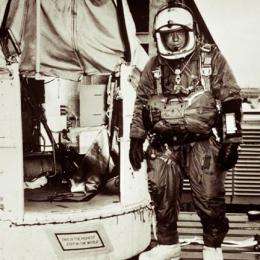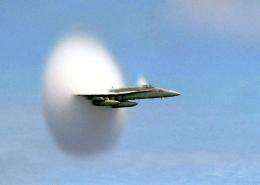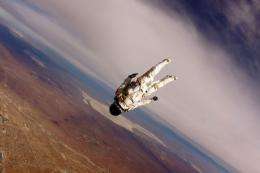Supersonic Freefall

The sound barrier was first broken by an aircraft in 1947, but this year a man will attempt to break the sound barrier with his body alone. His freefall jump from the edge of space will not only break records, but could contribute valuable information about human physiology for future space missions.
The speed of sound — historically called the 'sound barrier' - has been broken by rockets, various jet-powered aircraft and rocket-boosted land vehicles. Felix Baumgartner wants break the sound barrier with his body, in freefall from the edge of space. He will travel inside a capsule with a stratospheric balloon to 36,500 meters (120,000 feet) step out and attempt a freefall jump targeted to reach - for the first time in history - supersonic speeds.
"After years of training with my team of dedicated Red Bull Stratos experts, I'll be going on a journey that no one has ever done," Baumgartner told Universe Today in an email message. "If I succeed, I will be the first person to break the sound barrier, alone. That will be a record for all eternity. As such, a piece of me will become immortal. That excites me."
Back in 1960, a US Air Force captain named Joe Kittinger made aerospace history by making a jump from 31,000 meters (102,800 feet). His jump contributed valuable data that provided ground work for spacesuit technology and knowledge about human physiology for the US space program. There have been several attempts to surpass Kittinger's record, but none have succeeded, and people have given their lives for the quest.
Sometime during 2010, Baumgartner will make an attempt in his "Red Bull Stratos" mission — named after the energy drink that is sponsoring Baumgartner's attempt. His sponsors say the mission will explore the limits of the human body in one of the most hostile environments known to humankind, delivering valuable lessons in human endurance and high-altitude technology.
"This is the biggest goal I can dream of," Baumgartner said. "If we can prove that you can't break the speed of sound and stay alive I think that is a benefit for future space exploration."
But if Baumgartner is successful, the Red Bull Stratos mission will break four world records: the altitude record for freefall, the distance record for longest freefall, the speed record for fastest freefall by breaking the speed of sound with the human body, and the altitude record for the highest manned balloon flight.
How fast will Baumgarter need to go to beat the speed of sound? Sound travels at different speeds through the atmosphere (as well as through different mediums), depending on atmospheric density and temperature. For example, at sea level, in average conditions of about 15 degrees C (59 degrees F), sound travels at around 1,223 kph (760 mph). But at higher altitudes, where the air is colder, sound travels more slowly.
Researchers with the Red Bull Stratos mission anticipate Baumgartner could break the sound barrier at about 30,480 meters (100,000 feet) above sea level, in temperatures of -23 to -40 C (-10-40 F) where sound travels at about 1,110 kph (690 mph) or roughly 304 meters per second (1,000 feet per second).
So, he'll have to go faster than those speeds - or Mach 1 — to be supersonic.

While there is no literal “barrier,”the transition to supersonic speeds can cause problems for aircraft as transonic air movement creates disruptive shock waves and turbulence. Data obtained from Chuck Yeager's first supersonic flight in 1947 allowed for changes in design of supersonic aircraft to avoid problems. Still, some aircraft still experience problems, and going supersonic has been attributed to some air disasters.
And the human body isn't designed for supersonic speeds.
“Our biggest concern is that we don’t know how a human unencumbered by aircraft is going to transition through this," said the project's Medical Director Dr. Jonathan Clark, a flight surgeon for six space shuttle missions (and husband of astronaut Laurel Clark who died in the Columbia disaster in 2003), who has researched numerous aerospace disasters. "But it’s also exactly what we’re hoping to learn, for the benefit of future space flights.”
Documents provided by the Red Bull Stratos mission say that the data obtained from the mission will be shared with the scientific community, and Clark notes that he expects long-awaited medical protocols to be established as a result.
At the low temperatures and tenuous atmospheric conditions that Baumgartner will experience, he could suffer from hypothermia, the bends -if he gains altitude too fast during ascent -, or he could experience ebullism - the infamous condition where gas bubbles can form in the blood, and the blood basically "boils."
That's why his spacesuit is so important.

"I have absolute confidence the suit is going to work," said Daniel McCarter, Program Manager for the David Clark Company, the same company that made Kittinger’s suit back in 1960, as well as full pressure suits for NASA astronauts and military pilots flying in aircraft that can reach the edge of the atmosphere. "We are ultimately risking life. Felix realizes that his life is on the line. Our job is to do everything we can from an engineering and technical standpoint for view to keep him safe. Every time someone jumps a suit like this there is something to learn. We learn knowledge for future systems."
The suit Baumgartner will use is custom-made for him, so there should be no pressure points caused by the suit that would make him uncomfortable, but any pressure suit restricts mobility and dexterity. He will have to avoid movements that could cause him to go into an uncontrollable spin.
Baumgartner is not new to jumping. He owns several world records for B.A.S.E. jumping and is well known for skydiving across the English Channel in 2003. He is also a parachutist, stunt coordinator and a commercial helicopter pilot.
"I think I've always been one those guys who wanted to be in the places where no one has been before. Its inside your body or brain," Baumgartner said in a video on the Red Bull Stratos website. "When I was a kid, I liked to climb up trees -I always wanted to be on top of something."
This will definitely be an attempt where no one has gone before.
More information: felixbaumgartner.com/
The story has originally appeared on The Universe Today. Written by Nancy Atkinson.
Source: Astrobio.net

















